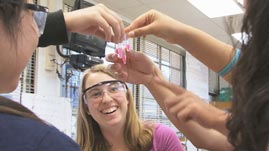Teachers' Domain - Digital Media for the Classroom and Professional Development
User: Preview

Source: Produced by WGBH Educational Foundation in association with the Amgen Foundation



In this video produced by WGBH, high school and middle school students in the Amgen-Bruce Wallace Biotechnology Lab Program make use of real-world research equipment and techniques to insert a recombinant DNA molecule into a bacterial cell. By using precision instruments and techniques, scientists can insert foreign genes into bacteria. Understanding how proteins behave inside cells can lead to a better understanding of human diseases such as Huntington’s, Alzheimer’s, and Parkinson’s. As a teacher, a university researcher, and an industry scientist attest in the video, this kind of laboratory experience provides students with a small window into the day-to-day life of a scientist.
Lab experiments like the one featured in this video provide students with hands-on experience using common biotechnology research tools and techniques. For students, this lab allows them to connect what they learn in the classroom to real science problems. In addition to providing a high degree of authenticity, these labs can serve to reinforce the importance of precision and collaboration in successful experimentation.
In this video, students are shown using micropipettes—precision instruments used to transfer very small but specific volumes of liquid from one vessel to another—in order to deliver DNA plasmid into a microfuge tube containing bacteria. All micropipettes are designed to be reliable and precise. Lab technicians and scientists must practice with them to deliver just the right volume of material in just the right way, as even small errors can be costly.
Successful experimentation in a high school lab, as in a professional research facility, relies on collaboration. It’s important that team members know which tasks have been assigned to each person and that members frequently communicate with one another. Failure to do so can lead to mistakes that can jeopardize an experiment or any other research objective.
Errors caused by poor lab technique or poor communication can contaminate samples, invalidate data, and waste precious materials and time. Having to repeat research experiments can be both time-consuming and expensive. The more experience students can get in a real-world setting the better prepared they’ll be for a career in science.
 Loading Standards
Loading Standards